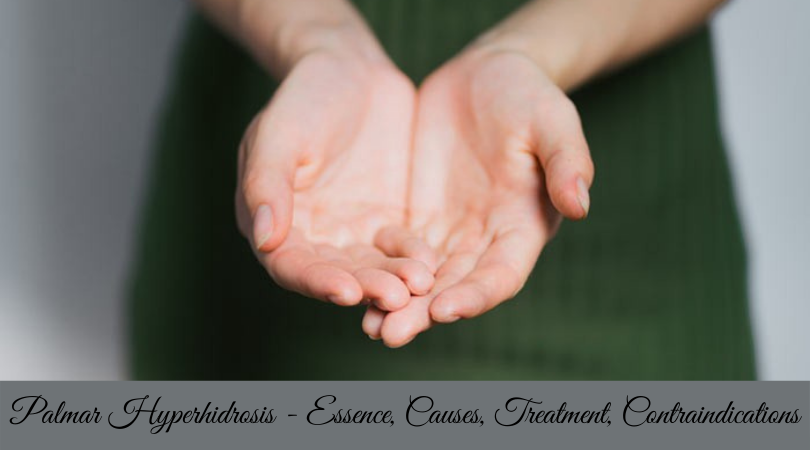 Hyperhidrosis is a condition characterized by excessive sweating that exceeds the natural needs for thermoregulation. Depending on the causes of excessive sweating, it is distinguished between primary and secondary hyperhidrosis.
Hyperhidrosis is a condition characterized by excessive sweating that exceeds the natural needs for thermoregulation. Depending on the causes of excessive sweating, it is distinguished between primary and secondary hyperhidrosis.
Secondary hyperhidrosis is essentially a symptom of another medical condition (such as tuberculosis or a neurological disorder). Overheating and febrile conditions (a rise in body temperature to 37.1-38.0 ° C) are common causes of its occurrence. In addition, secondary hyperhidrosis can cause systemic disease and medication. Increased sweating is present regardless of the time of day, sometimes mostly at night. Such hyperhidrosis disappears after the cure of the underlying disease, which led to excessive sweating.
Primary hyperhidrosis (or essential hyperhidrosis) is not associated with any disease or natural thermoregulation. This diagnosis requires the exclusion of other medical conditions. It is this form of hyperhidrosis that should be given special attention.
The onset of primary hyperhidrosis cannot be explained by the body’s needs. People suffering from primary hyperhidrosis do not differ physically from completely healthy people, and even the most detailed examinations do not find deviations in the state of their organs and functional systems. But for one reason or another, in such people, the center of emotionally conditioned sweating functions at a more active level, leading to such clinical manifestations.
Primary hyperhidrosis is often hereditary, i.e. often found in families and close relatives. This indicates its genetic nature, which is confirmed by a detailed genome study.
It is the most significant form of hyperhidrosis, which causes numerous problems in the social, emotional and professional spheres and can lead to severe personal consequences.
With severe palmar hyperhidrosis, everything that the patient touches becomes wet, so at school such children cannot write with ink pens, their notebooks and textbooks become wet, which causes misunderstanding of teachers and classmates. Since childhood, such people try to avoid shaking hands, touching, dancing, they cannot engage in some sports in which it is required to hold something in their hands – tennis, volleyball, shooting. There is difficulty with playing musical instruments (piano, violin, guitar).
In the professional field, constantly sweaty hands also lead to numerous restrictions – it is difficult to work with papers, precision mechanics, watches, electrical engineering and electronics, jewelry and optics, as well as work with people that requires handshakes and touching (masseur, hairdresser).
Palmar sweaty palm syndrome is isolated, but more often it is combined with plantar (foot), axillary, or both of the above forms at once.
Sweaty hands disease is manifested by very characteristic signs:
There are several stages of this pathology, depending on the severity of the symptoms:
The most common form of hyperhidrosis is idiopathic. It develops for no reason from infancy and worsens during adolescence. This form is not hazardous to health, but can cause complicated psychological problems.
In addition, there are many reasons that lead to the excessive hand sweating:
Today, there are various ways to correct and treat the problem of increased sweating:
One of the most effective, modern and safest ways to get rid of hyperhidrosis is the injection of Botox (USA) and Dysport (France). The procedure consists in injecting weakened botulinum toxin (which is part of the preparations) into the palms area. When injected into the problem area, the release of acetylcholine is blocked, which leads to long-term relief of the sweat glands’ functions.
The procedure is short in time, has no health consequences and does not require rehabilitation (there are no marks on the skin after treatment), and the effect develops as soon as possible (after one to two weeks).
The procedure is performed very quickly, in several stages, gives an excellent lasting result and has no side effects.
At the first stage, in order to estimate the area of botulinum toxin injection, a specialist conducts the Minor’s test. To do this, an iodine solution is applied to the skin of the palms, and then sprinkled with starch. When the sweat glands begin to work and sweat is released, an interaction between iodine and starch begins, and a black spot appears, which outlines the area for drug administration.
At the second stage, anesthesia and drug administration are performed:
The dosage of the drug is determined individually depending on the severity of hyperhidrosis. The result is noticeable within 7 days, but the greatest effect is achieved after 2 weeks and lasts from 6 to 18 months.
As with any procedure, botulinum therapy has its limitations. Absolute contraindications to treatment with Dysport and Botox are:
Relative contraindications for the administration of botulinum toxin are chronic diseases in the acute stage, a tendency to form keloid-type scars, hyperthermia.
© 2025 www.curesweatypalms.com. All rights reserved.